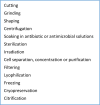Legal and Regulatory Challenges for Emerging Regenerative Medicine Solutions for Diabetes
- PMID: 37749797
- PMCID: PMC11042516
- DOI: 10.1097/TP.0000000000004797
Legal and Regulatory Challenges for Emerging Regenerative Medicine Solutions for Diabetes
Abstract
Regenerative medicine solutions for type 1 diabetes are a rapidly developing field of medical technology. To date, these solutions have been principally cell-based treatments and at present, in Europe, these therapies are regulated under European Union regulations for advanced therapy medicinal products. But now, new emerging technology combining cellular therapy with medical devices is under development. The potential of this novel hybrid model to create a bioartificial pancreas to treat type 1 diabetes is tantalizing. However, incorporating medical devices creates a further layer of regulatory complexity. This article seeks to expose the complexity of this legal and regulatory landscape and demonstrate how evolving technology could challenge the entire existing legal paradigm. We start by summarizing the status of the only established cell-based therapy-transplantation. We set out the regulation of cellular therapies, their classification, and the role of statutory bodies. We examine the bottleneck of therapies moving from bench to bedside, and we consider the additional challenges of products, which use a combination of cells and medical devices. Finally, we argue that for the potential of this rapidly growing area of technology to be realized a seismic shift in how we regulate frontier cellular therapies will be required.
Copyright © 2023 The Author(s). Published by Wolters Kluwer Health, Inc.
Conflict of interest statement
The authors declare no conflicts of interest.
Figures
References
-
- European Parliament. Directive 2001/83/EC relating to medicinal products for human use. Available at https://eur-lex.europa.eu/homepage.html.
-
- European Parliament. Directive 98/79/EC of the European Parliament and of the Council of 27 October 1998 on in vitro diagnostic medical devices. Available at https://eur-lex.europa.eu/homepage.html.
-
- European Parliament. Directive 2010/45/EU of the European Parliament and of the Council of 7 July 2010 on standards of quality and safety of human organs intended for transplantation. Available at https://eur-lex.europa.eu/homepage.html.
Publication types
MeSH terms
LinkOut - more resources
Full Text Sources
Medical



